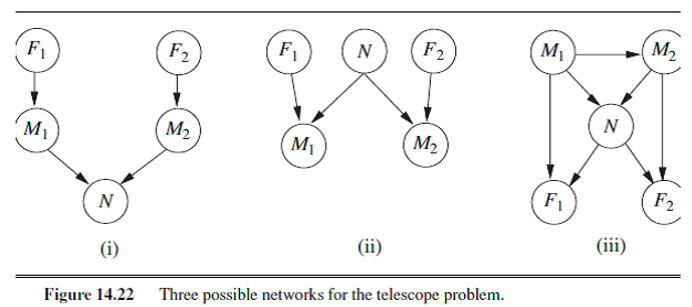Question
Two astronomers in different parts of the world make measurements M1 and M2 of the number of stars N in some small region of the
Two astronomers in different parts of the world make measurements M1 and M2 of the number of stars N in some small region of the sky, using their telescopes. Normally. There is a small possibility e of error by up to one star in each direction. Each telescope can also (with a much smaller probability f) be badly out of focus (events F l and F 2 ), in which case the scientist will undercount by three or more stars (or if N is less than 3, fail to detect any stars at all). Consider the three networks shown in Figure 14.22.
a. Which of these Bayesian networks are correct (but not necessarily efficient) representations of the preceding information?
b. Which is the best network? Explain.
c. Write out a conditional distribution for P(M 1 , | N), for the case where N e {1, 2, 3} and MI e {0, 1, 2, 3, 4}. Each entry in the conditional distribution should be expressed as a function of the parameters e and /or f.
d. Suppose M l =1 and M 2 =3. What are the possible numbers of stars if you assume no prior constraint on the values of N?
e. What is the most likely number of stars, given these observations? Explain how to compute this, or if it is not possible to compute, explain what additional information is needed and how it would affect the result.

F M N (i) Figure 14.22 F M F N M (ii) F2 M Three possible networks for the telescope problem. M F N (iii) M F2
Step by Step Solution
3.44 Rating (160 Votes )
There are 3 Steps involved in it
Step: 1
a The correct networks are ii and iii N depends conditionally on both M1 and F1 as well as ...
Get Instant Access to Expert-Tailored Solutions
See step-by-step solutions with expert insights and AI powered tools for academic success
Step: 2

Step: 3

Ace Your Homework with AI
Get the answers you need in no time with our AI-driven, step-by-step assistance
Get Started


